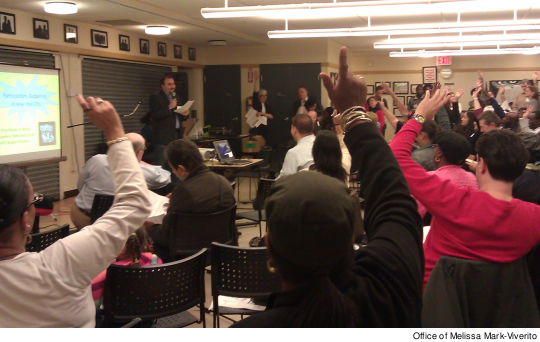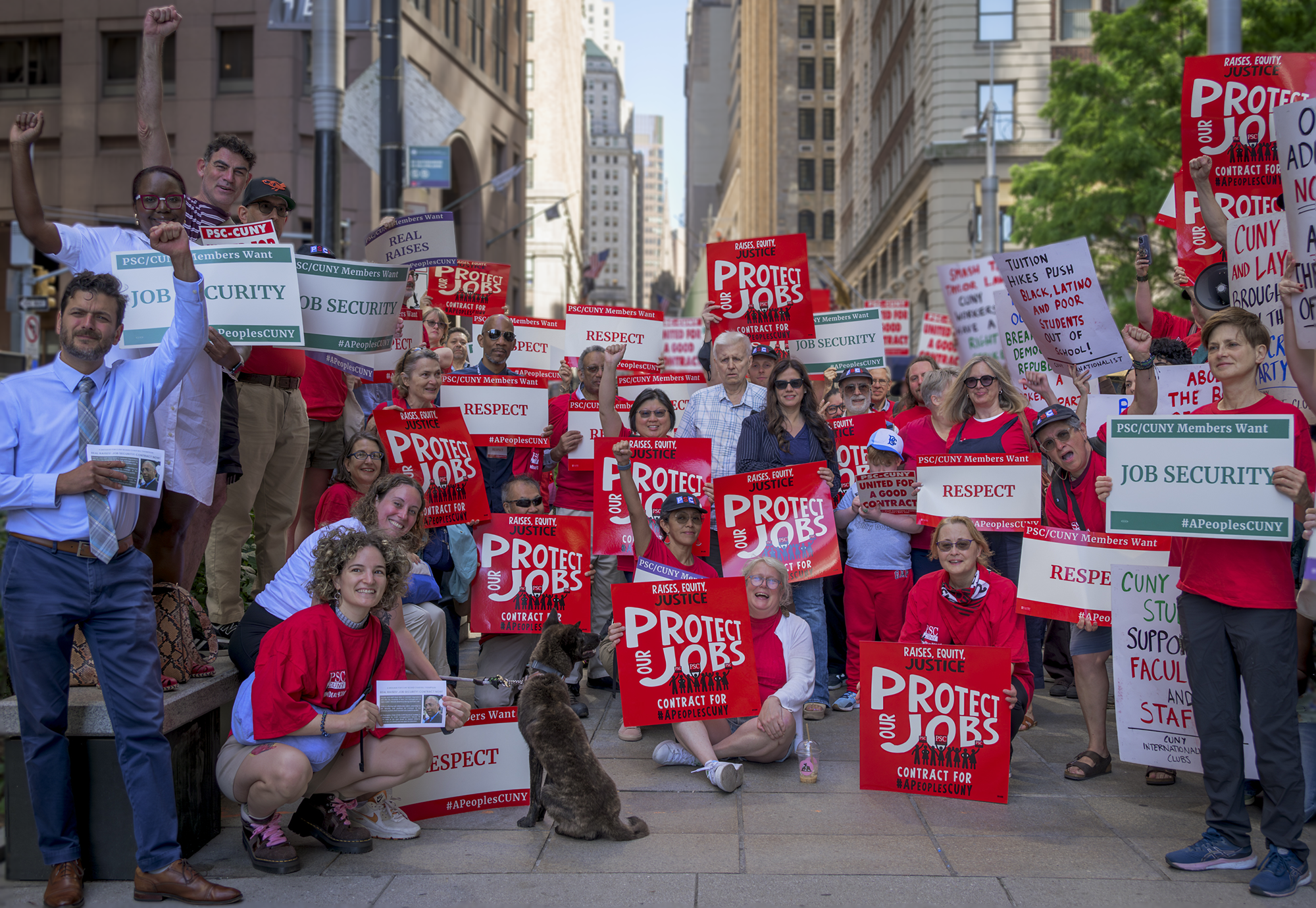Like much of the rest of the globe, New York City is beset by two crises: economic instability and the changing climate. Any hope of making our intensely unequal and unsustainable city more equitable and resilient requires fundamental changes in the relationship between the government and its people, and between the economy and its infrastructure. This requires more than a change of administrations; it requires a reconstruction of the governance process itself.
Though this sounds daunting, there are movements implementing innovative models right here in NYC that could provide a roadmap for forging a more democratic and sustainable future. One such model is participatory budgeting (PB) – a democratic process in which community members directly decide how to spend some part of a public budget. We think participatory budgeting could play a key role in moving NYC in a new direction, and CUNY and unions such as the PSC are well positioned to be vital actors in this effort.
 |
A New Model
Last summer, the Bloomberg administration unveiled a $20 billion plan to make New York City more “resilient.” Drafted by the NYC Economic Development Corporation, the Special Initiative for Rebuilding and Resiliency (SIRR) calls for the transformation of infrastructures and institutions so that this coastal financial capital might adapt to the changing climate and withstand its more dramatic onslaughts. The SIRR report calls for changes to communications, transportation, housing, financing, energy and even city government itself.
Can the typical “pro-growth” model of economic development run by a quasi-accountable public-private partnership, with government subsidies for low-wage retail jobs and luxury condos, make NYC more resilient? SIRR says “yes.” But how many will fit into this exclusive lifeboat? What about the “other half”? We believe participatory budgeting harks toward a different kind of collaboration, a social-public partnership.
Bill de Blasio’s landslide victory was largely the result of an unrelenting focus on a single theme: the human devastation caused by rising inequality. This widening gulf between rich and poor is intimately bound up with NYC’s efforts to respond effectively to climate change. Too many New Yorkers suffered from inadequate housing and services before Hurricane Sandy. (Mold, made so much worse by climate change, has been an issue for New York City Housing Authority tenants for years.) And for far too many, waves of gentrification have displaced and degraded communities with a force not unlike a 100-year flood. Any program for making NYC “resilient,” then, requires repairing damage from these two very different kinds of superstorms.
Participatory budgeting offers a model for community-based development and people-powered governance that can foster a more democratic, inclusive resilience – an approach that will truly leave New York a stronger city.
Three years ago, four NYC Council members worked with the Participatory Budgeting Project and with Community Voices Heard to set up a process that gave residents in their districts real power to decide how public money is spent. Modeled after an effort at grassroots governance pioneered two decades ago in Porto Alegre, Brazil, PB NYC has enabled thousands of residents to decide how to spend millions for projects to improve their neighborhoods (see pbnyc.org).
How Participatory Budgeting Works
First, a City Council member agrees to dedicate $1 million of his or her own capital discretionary funds to the process. Each fall, community leaders reach out to residents in their council district, organizing public assemblies to explain PB. At these gatherings, residents discuss district needs in a facilitated face-to-face setting and propose ideas to address those needs. From November to February, interested residents step up to collectively develop those ideas into full-fledged proposals. Anyone age 13 and older can participate in neighborhood assemblies and budget delegate meetings, including the foreign-born and formerly incarcerated.
These “budget delegates” work with City agencies to make sure proposals meet the City’s fiscal and technical requirements. For example, a proposal for a solar-powered greenhouse from residents of a public housing complex must be verified by city officials to confirm that it is legally and technically feasible at a specific site. If the proposal passes those tests, it is placed on a ballot that the residents of the district vote upon in March. (To participate and vote one needs to be 16 or older and a resident of the district). The winning proposals are submitted to the City.
Meeting Public Priorities
Over the first two years of PB NYC, winning projects have reflected neighborhood priorities: education, safety, sustainability and public space. Some are familiar: computer classrooms for underfunded schools, improvements to parks, countdown clocks for dangerous intersections. Others are more “out of the box,” such as places for large-scale composting (District 39) and the solar-powered greenhouse noted above. One of our favorites involves a truly innovative way to address the problem of “food deserts”: a bus with a kitchen to teach kids how to cook sustainable, healthy meals that can reach children where they live (District 8).
Not only do the projects address needs, so does the process. Though PB is time-consuming (each process lasts several months), “efficiency” is in many ways increased. The multiplicity of players leads to a more wide-ranging scrutiny of proposals, thereby reducing the chances that a poorly thought-out proposal favored by some unfairly influential group is pushed through. When done right, such public deliberation displaces the power of lobbyists, exposes patronage, reduces partisanship and breaks through gridlock. Our own studies have shown that PB is also more inclusive and attractive than local elections in terms of race and class.
This democratic deepening of the process has major advantages, since more types of knowledge and imagination are brought to the table as experts from City agencies work alongside “amateurs,” and longtime residents with intimate knowledge of people and place brainstorm with recent immigrants who bring ideas outside of any given cultural or geographic box. This kind of pluralist collaborative epistemology is crucial for dealing with the ecological complexities that the region is facing post Sandy and in its efforts to tackle rising inequality.
Projects like SIRR and the ongoing Rebuild by Design lack the informed popular participation that is cultivated in PB, so their ability to tackle inequality and empower communities is drastically impaired. Indeed, such processes could produce an incredibly undemocratic “resilience.” We have seen glimpses of this in calls for capital-intensive Battery Park-style residences that might appear ecologically resilient, but are in reality socially unsustainable gated communities. Even more sensible low-cost options like public rain gardens in Red Hook that would absorb storm waters are ecologically appropriate, but could also promote gentrification if there are no protections for present residents.
A democratic resilience is within reach, but it requires the right process to get there. PB has much to offer in this regard, but it needs help. Making sure that those most in need of basics goods, and of the powers required to exercise their “right to the city,” requires a city government committed to supporting genuine participation. There are more than 1000 PBs across the world and research shows the most inclusive, accountable and empowering are those where the government is a consistently supportive partner. In PB NYC, the community-based organizations who make the process work have not received nearly enough support. Both the City and civil society organizations need to fill this gap – and that’s where the PSC and CUNY come in.
This year, nine City Council districts across four boroughs are doing participatory budgeting. More than 20 council members have pledged to do it next year. PB is an excellent educational opportunity for students to experience democracy in action. The process itself is a place of learning from and about one’s neighbors and their communities and about how city government works with all its attendant complexities.
At Brooklyn College last year, a few students became budget delegates and worked with City agencies to develop proposals. They learned the nitty-gritty of the approval process for capital projects. This year and next, the PSC and faculty, students and staff at CUNY could help more students have this kind of urban-learning experience by assisting with outreach, research, translation of materials, and fundraising in the PB process.
CUNY’s Role
CUNY community members could help get out the vote for this year’s PB elections, which will take place around the end of March. Next year, social science classes could do interviews with residents about needs and assist the PB NYC research team; science classes could present information about infrastructure and climate change; liberal arts classes could help communities present their visions and voices.
And CUNY itself could experiment with PB. When Brooklyn College’s student government took up PB, the college administration was so impressed that it contributed matching funds. And why not bring unions into the mix? In Latin America, PB has been used not just for capital projects, but workforce development. Perhaps the PSC, working with other unions, could put together such a project in NYC.
Participatory budgeting can give residents real decision-making power about things that matter. Our research has shown that it actively includes people of color and immigrants, young and old in a process that empowers people to collectively remake their neighborhoods. As the effects of climate change accelerate, our region’s collective future is up in the air and billions in federal funds are in play. Such people-powered processes could shape solutions to the twin storms of economic inequality and climate change.
Now imagine every CUNY campus being a hub for PB activity! This social-public partnership could give faculty, staff and students an inclusive and democratic space to provide a deeper education, and help shape the future of the city we all have a stake in.
Michael Menser is an assistant professor of philosophy at Brooklyn College and President of the Board of the Participatory Budgeting Project (www.participatorybudgeting.org). Ron Hayduk is professor of political science at Queens College and a member of the Participatory Budgeting NYC Research Board.

